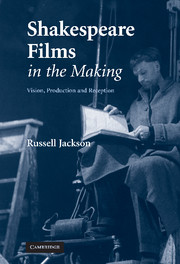Book contents
- Frontmatter
- Contents
- Acknowledgements
- List of illustrations
- Abbreviations
- Introduction: ‘Such stuff as dreams are made on’
- 1 Max Reinhardt's recurring Dream: Hollywood, 1935
- 2 Historical-pastoral: Laurence Olivier's Henry V, 1944
- 3 Visions of Renaissance Italy
- Appendix: Unpublished script materials
- Filmography
- Notes
- Bibliography
- Index
Appendix: Unpublished script materials
Published online by Cambridge University Press: 06 August 2010
- Frontmatter
- Contents
- Acknowledgements
- List of illustrations
- Abbreviations
- Introduction: ‘Such stuff as dreams are made on’
- 1 Max Reinhardt's recurring Dream: Hollywood, 1935
- 2 Historical-pastoral: Laurence Olivier's Henry V, 1944
- 3 Visions of Renaissance Italy
- Appendix: Unpublished script materials
- Filmography
- Notes
- Bibliography
- Index
Summary
Scripts referred to in the text are listed in chronological order for each film, with page totals. After the initial stages of development, page and scene/shot numbers are usually constant through a series of drafts, to ensure accuracy of reference during production. Additional pages and scenes/shots are normally indicated by letters (‘1A’, etc.). These are commonly issued on coloured paper by the script (or ‘continuity’) supervisor. Practice varies regarding the terms used by studios to describe the status of drafts (‘Complete’, ‘Final’, etc.): the classification here is that given on the document, with the exception of ‘shooting script’, which here indicates scripts used during filming. ‘Release’ scripts, or ‘cutting continuities’ are an account of the state of the completed film, used to check copies or (in the case of the Albany collection) issued for precensorship and certification purposes. Where copies are labelled, numbered, date-stamped or annotated by issuers or users, the appropriate details have been included. For the 1935 A Midsummer Night's Dream and 1936 Romeo and Juliet, draft material not amounting to a full version of the script has been included.
Information
- Type
- Chapter
- Information
- Shakespeare Films in the MakingVision, Production and Reception, pp. 222 - 227Publisher: Cambridge University PressPrint publication year: 2007
